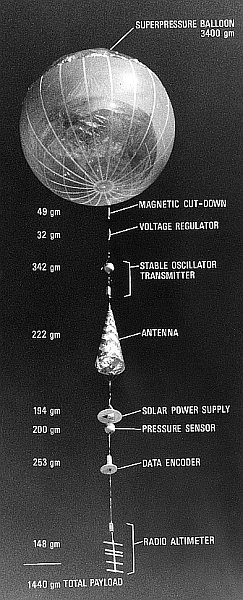 TWERLE (Experiment)
TWERLE (Experiment)

TWERLE was the acronym for Tropical Wind, Energy Conversion, and Reference Level Experiment a joint balloon program of the NASA Goddard Space Flight Center, the University of Wisconsin, and the National Center for Atmospheric Research (NCAR) carried out during 1975 as part of the Global Atmospheric Research Program (GARP).
The original scientific objectives of the experiment were to obtain an adequate density of wind and temperature measurements in the tropical upper troposphere with the purpose of studying the interactions of tropical circulation systems with those of middle latitudes; to obtain data on the pressure gradients along balloon trajectories that can be related to the rate at which potential energy is converted to kinetic energy in the upper atmosphere; to study the need for and the characteristics of an in situ measurement of pressure and temperature at a known geometric altitude and to investigate various modes of gravity waves in the upper tropical troposphere and lower mid-latitude stratosphere.
The TWERLE platform consisted of a non extensible superpressure balloon of 5.5 meters of diameter designed to float on a constant density surface equivalent to 150 milibars (44.600 ft). Each balloon carried a train of instruments bellow including sensors to detect ambient temperature, pressure, and geometric altitude above the sea surface. Also was included a geomagnetic field sensing device to cut down the platform should it move north of 20º N geomagnetic latitude as a security measure. The reason was the Cold War tensions with Russia, China and other countries in the north hemisphere that had denied the overflight of their land masses even by small scientific balloons.
The TWERLE balloons were fitted with all the necessary electronics, solar-cell array, and antenna to transmit once each minute, 400 Mhz signals to the Nimbus-6 satellite which carried onboard an experiment designed to locate and collect data from a large number of drifting platforms, based on the Doppler signal transmited by the balloons. Hence, in the daylight portion of each orbit the spacecraft detected, demodulated, and stored these Doppler signals along with sensor telemetry for all balloons within range of the satellite and transmited back to Boulder, Colorado for storage and analysis at NCAR.
A total of 395 TWERLE balloons were successfully launched during the summer and early fall in 1975 from three launch sites in the southern hemisphere. 47 balloons were flown from Accra, Ghana; 109 from Ascension Island in the Atlantic Ocean and 102 from Pago-Pago, American Samoa in the Pacific Ocean.
A subsequent mid-latitude phase took place from November 1975 to February 1976 on which 135 balloons were launched from Christchurch, New Zealand

